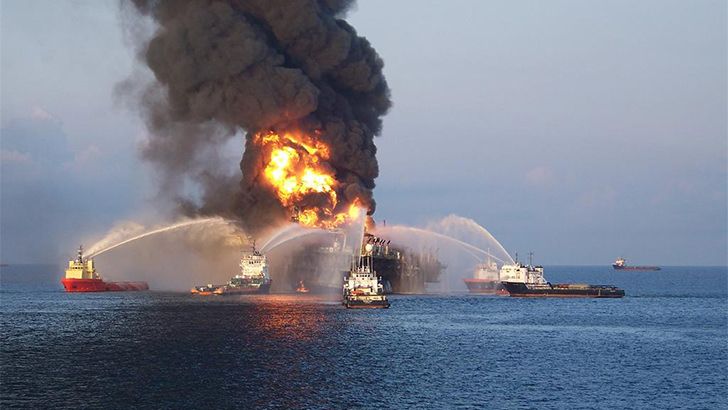Deepwater Horizon: The Lasting Impact of America’s Largest Oil Spill
Published on by Water Network Research, Official research team of The Water Network in Social
Eight years later, USF’s Center for Integrated Modeling and Analysis of Gulf Ecosystems has received $36 million in funding for its continued research into the 2010 spill
Story by Benjamin Prueitt, C-IMAGE Consortium

The Deeptwater Horizon drilling platform after the initial explosion on April 20, 2010. Credit: USCG
On April 20, 2010, the Deepwater Horizon oil platform operated by BP, was disconnecting from a recently discovered oil reservoir 50 miles south of Louisiana when a cascade of equipment malfunctions caused a high-pressure explosion, killing 11 rig workers. For two days the rig burned then sank. As response crews worked to extinguish surface fires, oil and gas from the broken drill pipe was spewing a mile deep in the Gulf of Mexico.
This underwater geyser of oil and gas lasted 87 days as remotely operated vehicles tried several methods to stop the flow. Success eventually came with a “top-kill” effort in August, but not before nearly 210 million gallons of oil and almost 2 million gallons of dispersants contaminated the Gulf of Mexico. Shortly following the capping of the wellhead, breaking news of the spill’s events stopped as the national attention moved onto other headlines.
This media vacuum is common following environmental disasters (Fukushima, Zika virus, the Exxon Valdez oil spill) as a crisis is considered “over” once news headlines turn elsewhere. But this mindset ignores the efforts of dedicated individuals looking for solutions to the causes, and consequences of such disasters years after they occur.
In the case of the Deepwater Horizon oil spill – which is remembered eight years ago this week – scores of USF researchers and students have dedicated their studies to the causes and environmental consequences of marine oil blowouts so that society is more prepared in the event of the next mega spill, even without national media attention.
The University of South Florida and the Florida Institute of Oceanography took emergency action in the weeks following the 2010 spill, dispatching researchers to areas of the Gulf not yet touched by the millions of gallons of spilled oil. USF collected samples of nearly everything: water, sediment cores from the seafloor, fish bile, liver, as well as muscle and plankton samples.
These samples were used as evidence during litigation against BP, resulting in the energy giant paying $18.7 billion to federal, state, county and municipal governments in 2015 as penalties for the spill; including $1 billion for Tampa Bay governments.
Read full article: University of South Florida
Media
Taxonomy
- Oil & Gas
- Decontamination
- Oil Water Separation
- Decontamination
- Disaster Prevention
- Oil Sand Extraction
- Pollution
- Disaster Relief
- Oil Field Chemicals
- Oil Spill Treatments
- Oil Production Platforms
- Pollution
- Pollution
- Disaster Management